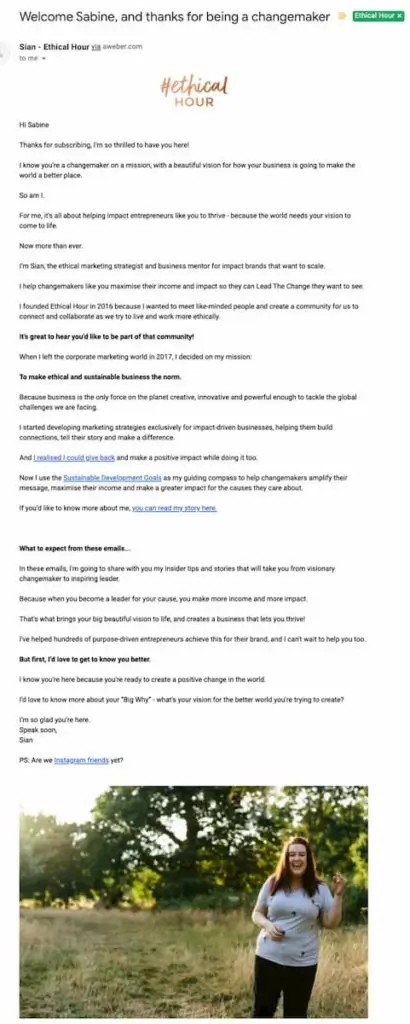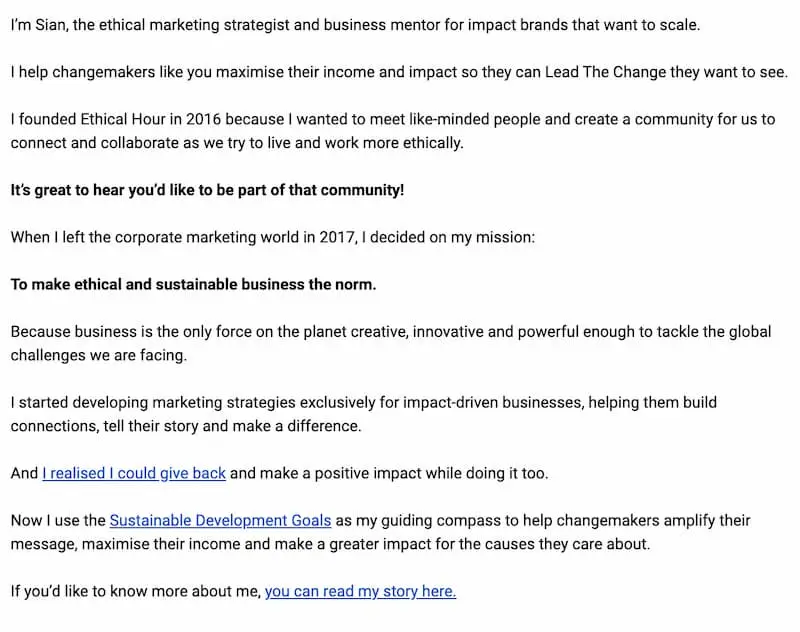Email Clinic #1: Ethical Hour — Making Newsletter Subscribers Feel Good About Signing Up
Written by:
Starting a series of posts in which we take a close look at one specific email — putting a positive spin on “copy teardowns”.
About these Email Clinics
Copy “tear-downs” are having a bit of moment on the internet. For years, we’ve resisted the urge to take part in this movement — even though we LOVE looking at specific copy examples in detail and suggesting improvement ideas.
The thing is, we don’t like criticising brands behind their backs.
So we’ve developed Clinics as our own version of these “teardowns”. For a limited time only, members of the #Ethicalhour community had the chance to get an in-depth video assessment of their email copy, free of charge: what it looks like, how it reads, what’s working really well, and what could be improved.
This series of articles presents a summary of each assessment, so we can all learn from these emails together. You may also want to sign up to these newsletters just to see what changes were made based on the clinics!

Hi Sabine
Thanks for subscribing, I’m so thrilled to have you here!
I know you’re a changemaker on a mission, with a beautiful vision for how your business is going to make the world a better place.
So am I.
For me, it’s all about helping impact entrepreneurs like you to thrive – because the world needs your vision to come to life.
Now more than ever.
I’m Sian, the ethical marketing strategist and business mentor for impact brands that want to scale.
I help changemakers like you maximise their income and impact so they can Lead The Change they want to see.
I founded Ethical Hour in 2016 because I wanted to meet like-minded people and create a community for us to connect and collaborate as we try to live and work more ethically.
It’s great to hear you’d like to be part of that community!
When I left the corporate marketing world in 2017, I decided on my mission: To make ethical and sustainable business the norm. Because business is the only force on the planet creative, innovative and powerful enough to tackle the global challenges we are facing.
I started developing marketing strategies exclusively for impact-driven businesses, helping them build connections, tell their story and make a difference.
And I realised I could give back and make a positive impact while doing it too.
Now I use the Sustainable Development Goals as my guiding compass to help changemakers amplify their message, maximise their income and make a greater impact for the causes they care about.
If you’d like to know more about me, you can read my story here.
What to expect from these emails…In these emails, I’m going to share with you my insider tips and stories that will take you from visionary changemaker to inspiring leader.
Because when you become a leader for your cause, you make more income and more impact.
That’s what brings your big beautiful vision to life, and creates a business that lets you thrive!
I’ve helped hundreds of purpose-driven entrepreneurs achieve this for their brand, and I can’t wait to help you too.
But first, I’d love to get to know you better.
I know you’re here because you’re ready to create a positive change in the world.I’d love to know more about your “Big Why” – what’s your vision for the better world you’re trying to create?
I’m so glad you’re here.
Speak soon, Sian
PS: Are we Instagram friends yet?
Welcome Email to New Subscribers to Ethical Hour: First Impressions
The first email you receive after joining the Ethical Hour Community uses a very clean design with a nice picture of founder Sian Conway at the bottom.
It’s a relatively long email, but not unusually long.
Apart from the Ethical Hour logo at the top, there’s very little “fancy design” in this email.
Some bold text, some links — that’s all.
In the rest of this article, we’ll just start at the top of the email and walk our way down, showing you what we noticed when reading this email.
The Subject Line
Tip: “welcome” isn’t enough — make it meaningful

Welcome Sabine, and thanks for being a changemaker
Sian – Ethical Hour via aweber.com
This email is a particularly good example of how to use the subject line to draw people into your newsletter. I spot my name immediately, so I feel like Ethical Hour cares about me and I’m not just a number on the list of subscribers.
And it’s not just the typical “thanks for subscribing” type of subject line either: this one is a little bit different. Yes, it has the word “welcome”, which you might typically find in a subject line like this. But then it says, “thanks for being a changemaker”. This injects some meaning into my choice of signing up to this newsletter. Suddenly, it’s not jut about the newsletter anymore. The fact that I get these emails is now about something deeper, something more meaningful.
And by thanking new subscribers for something that goes beyond subscribing, you’re building a relationship that runs deeper than just transactions. From the very beginning, the relationship is defined by more than just commerce. We’re part of the same movement, we share the same values, there’s a little bit of a bond growing between us that goes deeper than your typical newsletter relationship.
How to write a great subject line
- When you write your own subject lines, you want to stand out and be a bit different from what other people send in the same situation.
- You also want to be either shorter or longer than the majority of subject lines, so you stand out more in people’s inboxes.
- You don’t have to tell the whole story in your subject line. The subject line has one job: to get people to open the email. Once that’s done, really the subject line has done everything it needed to do.
The Sender Information
Tip: don’t just have your company in the sender information
The sender info is often overlooked, but it’s such a powerful aspect of your email setup.
Sian has put both her name and her company into the sender information. Her email is instantly more likely to resonate on a personal level, because we’ve got her own personal name here, not just the company name. At the same time, though, should you not know who Sian is, then “Ethical Hour” reminds you what this newsletter is all about.
If you really want a relationship that goes a little bit beyond just transactions, it’s really helpful to let someone “own” the newsletter. Whether it’s the founder, the head of marketing or just a member of the team, I encourage you to come out from behind the brand name and be the face of the company.
It will supercharge your trust-building efforts and grow your credibility as thought leaders.
Starting the Welcome Email so Recipients Want to Read It
Tip: start a conversation

Hi Sabine
Thanks for subscribing, I’m so thrilled to have you here!
I know you’re a changemaker on a mission, with a beautiful vision for how your business is going to make the world a better place.
So am I.
For me, it’s all about helping impact entrepreneurs like you to thrive – because the world needs your vision to come to life.
Now more than ever.
The start of this email really feels like it’s a conversation with Sian. One reason why is the minimal design. All the pretty layouts and templates we know from e-commerce can show off your products in a stunning setting — but if they don’t elevate your message, and they don’t help with relationship building.
If you’ve got something important to say, and you want that one-to-one feel, the best thing you can do is to stay as close to an email that you would send from your personal inbox.
You’ll also be more likely to keep people on your list of subscribers for longer. They’ll feel less inclined to unsubscribe when they have no acute need for your products or services because they’ll appreciate the direct conversation with you.
Sian’s welcome email validates and reaffirms my choice of subscribing by adding emotion and meaning to my click: she’s “thrilled” to have me on her list and acknowledges me as a “changemaker on a mission, with a beautiful vision”. Sian makes her new subscribers feel that their actions have made a difference.
The email then establishes those shared values and elegantly transitions into the introduction of who’s writing.
Introducing the Person Behind the Newsletter
Tip: even when it’s about you, it’s really about your reader

I’m Sian, the ethical marketing strategist and business mentor for impact brands that want to scale.
I help changemakers like you maximise their income and impact so they can Lead The Change they want to see.
I founded Ethical Hour in 2016 because I wanted to meet like-minded people and create a community for us to connect and collaborate as we try to live and work more ethically.
It’s great to hear you’d like to be part of that community!
When I left the corporate marketing world in 2017, I decided on my mission:
To make ethical and sustainable business the norm.
Because business is the only force on the planet creative, innovative and powerful enough to tackle the global challenges we are facing.
I started developing marketing strategies exclusively for impact-driven businesses, helping them build connections, tell their story and make a difference. And I realised I could give back and make a positive impact while doing it too.
Now I use the Sustainable Development Goals as my guiding compass to help changemakers amplify their message, maximise their income and make a greater impact for the causes they care about.
If you’d like to know more about me, you can read my story here.
This section could be improved in a few ways.
- The most obvious improvement would be moving the picture of Sian from the bottom to this introductory section. The ideal photo placement would be right of the text so it doesn’t interrupt the flow of reading.
- There’s a surprisingly tentative note in the sentence: “It’s great to hear you’d like to be part of that community” (emphasis ours). We thought by subscribing we’re already a part of that community — so this sentence confused us a bit. The use of the conditional (would like to be) says that membership isn’t (yet) a fact, merely a possibility.
- Balance “I” with “you”. Perhaps unsurprisingly, the introduction has a lot of sentences starting with “I”. And even though such an introduction in the first email is extremely useful, readers will mainly want to know what’s in it for them, now that they’ve subscribed. The challenge is to turn all the information you want to share about yourself around so your reader understands how that benefits them.
For example:
Before: I’m Sian, the ethical marketing strategist and business mentor for impact brands that want to scale. I help changemakers like you maximise their income and impact so they can Lead The Change they want to see.
After: I’m Sian, the ethical marketing strategist and business mentor for impact brands that want to scale. In these emails, you’ll find tips and advice to help you maximise your income and impact so you can Lead The Change you want to see.
- This section contains three links: one for the Sustainable Development Goals (SDGs), one for giving back, one for reading Sian’s story. If you choose to add links, it’s good to have a strategy in mind for each one. Clicking the link shouldn’t just be a matter of curiosity — there needs to be something in it for the reader. So, when adding a link, it’s good to ask yourself:
- What can people do on these pages?
- What is the next step they can take from there to improve something in their own world? Perhaps they can learn how to adopt the Sustainable Development Goals in their work and life. Perhaps they can find inspiration on how to give back. Or they can see an encouraging example of how to tell the origin story of a business.
- What’s the immediate takeaway and value for the reader?
- Can you use these links to segment your readers by tagging them according to what they clicked? This would, for example, tell you who’s interested in storytelling, who’s interested in the SDGs, and who’s interested in giving back.
Introducing the Newsletter Itself
Tip: build anticipation and excitement from the get-go

What to expect from these emails…
In these emails, I’m going to share with you my insider tips and stories that will take you from visionary changemaker to inspiring leader.
Because when you become a leader for your cause, you make more income and more impact.
That’s what brings your big beautiful vision to life, and creates a business that lets you thrive!
I’ve helped hundreds of purpose-driven entrepreneurs achieve this for their brand, and I can’t wait to help you too.
The Welcome email should set the tone and the “programme” for the entire newsletter so the reader is more likely to look forward to your next email.
Sian’s email uses terms like “insider tips and stories” and paints a picture of the future that her readers desire.
Getting to Know Your Subscribers
Tip: train your new readers to take action at the end of your emails
The email ends:

But first, I’d love to get to know you better.
I know you’re here because you’re ready to create a positive change in the world.
I’d love to know more about your “Big Why” – what’s your vision for the better world you’re trying to create?
I’m so glad you’re here.
Speak soon, Sian
PS: Are we Instagram friends yet?
This section in Sian’s Welcome email represents an often-overlooked purpose of that very first email. Welcome emails are a great opportunity to start the kind of relationship where readers reply, click through to content and really engage with the email rather than just reading and deleting it.
Getting replies is the true measure of success, especially when your email list is small. Also — if you start the conversation early, you’ll have a much better chance of driving that engagement consistently, even when running a sales campaign.
Sian uses a clever open question to invite those replies: what’s your Big Why? The question is so emotive that it’s bound to incite people to reply. To increase response rates even more, it’s worth adding an explicit call to action.
For example: “What’s your vision for the better world you’re trying to create? Hit reply and let me know.”
Because sometimes, you just need to tell people exactly the steps that they need to take. If you wanted to take it one step further, you could even give them a sentence starter and say,
‘Tell me what your Big Why looks like. Hit reply and let me know:
“My vision for the better world I’m trying to create is…”’
Because when we give people a sense to complete, we reduce the perceived effort of answering the question and they’re more likely to take action.
Signing off
Tip: set up your next email and don’t underestimate the power of the P.S.
Sian signs off her email in a warm, conversational tone. “Speak soon” is a gentle pointer telling the reader that the next email isn’t too far in the future and encourages them to look out for it. To increase that effect, it can be useful to be a little more specific about the time frame: for example, “speak tomorrow” or “speak next week”.
Some readers gravitate towards the P.S. For some, it’s the first thing they read — perhaps because it stands out.
Sian uses the P.S. to invite new subscribers to connect on Instagram: “Are we Instagram friends yet?”
Yes-no questions are tricky little beasts in copywriting. Rhetorical questions don’t do the relationship any favours (they’re too easily misunderstood). They’re also less likely to incite people to take action.
So, you’ll need to have a clear plan for what to do if people say no. As with asking for replies, an explicit call to action works best. After all, we’ve got some inertia to overcome. Just asking the question makes it too easy for the reader to just say “no” and close the email.
For example:
“Are we Instagram friends yet? I share ethical marketing tips and tips to make more impact. Follow me here.”
Summary
Validate your subscribers, give instant value & be strategic with your calls to action
To sum up, Sian uses a brilliant subject line. The email design supports the personal feel of the content. The beginning of the email adds wonderful meaning and gravitas to the reader’s decision to sign up.
The introduction could be improved by moving the photo higher up and relating each fact about Sian to a positive outcome for the reader.
There’s a question about the strategy behind the links and whether they’re used for segmentation or to giv the reader instant value.
Sian sets up a sense of anticipation by explaining what to expect from her emails and uses the opportunity to get to know her new reader.
To drive more engagement, it’s worth testing more explicit calls to action in addition to the questions asked in the email, or even a sentence starter that readers can complete.
Well done, Sian!
